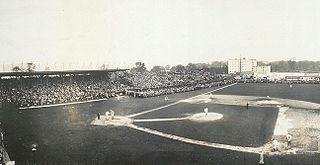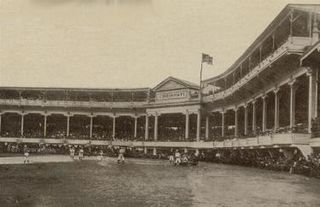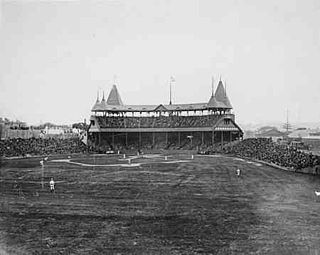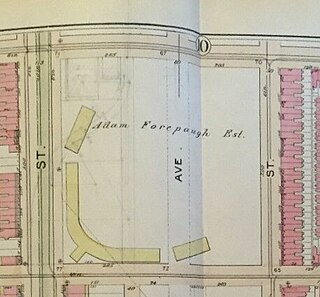
Shibe Park, known later as Connie Mack Stadium, was a ballpark located in Philadelphia. It was the home of the Philadelphia Athletics of the American League (AL) and the Philadelphia Phillies of the National League (NL). When it opened April 12, 1909, it became baseball's first steel-and-concrete stadium. In different eras it was home to "The $100,000 Infield", "The Whiz Kids", and "The 1964 Phold". The venue's two home teams won both the first and last games at the stadium: the Athletics beat the Boston Red Sox 8–1 on opening day 1909, while the Phillies beat the Montreal Expos 2–1 on October 1, 1970, in the park's final contest.

National League Park, commonly referred to as the Baker Bowl after 1923, was a baseball stadium and home to the Philadelphia Phillies from 1887 until 1938, and first home field of the Philadelphia Eagles from 1933 to 1935. It opened in 1887 with a capacity of 12,500, burned down in 1894, and was rebuilt in 1895 as the first ballpark constructed primarily of steel and brick, and first with a cantilevered upper deck. The ballpark's first base line ran parallel to Huntingdon Street; right field to center field parallel to North Broad Street; center field to left field parallel to Lehigh Avenue; and the third base line parallel to 15th Street. The stadium was demolished in 1950.

Hilltop Park was the nickname of a baseball park that stood in the Washington Heights neighborhood of Manhattan. It was the home of the New York Yankees of Major League Baseball from 1903 to 1912 when they were known as the "Highlanders". It was also the temporary home of the New York Giants during a two-month period in 1911 while the Polo Grounds was being rebuilt after a fire.

Palace of the Fans was a Major League baseball park located in Cincinnati, Ohio. It was the home of the Cincinnati Reds from 1902 through 1911. The ballpark was on an asymmetrical block bounded by Findlay Street (south), Western Avenue, York Street (north) and McLean Avenue (west).

South End Grounds refers to any one of three baseball parks on one site in Boston, Massachusetts. They were home to the franchise that eventually became known as the Boston Braves, first in the National Association and later in the National League, from 1871 through part of the 1914 season. That stretch of 43 1/2 seasons is still the longest tenure of the Braves club at any of their various ballparks and cities since 1914.
Boundary Field, also known as American League Park II and National Park, is a former baseball ground in Washington, D.C. located on the site currently occupied by Howard University Hospital; bounded approximately by Georgia Avenue, 5th Street, W Street and Florida Avenue, NW. It was just outside what was then the city limit of Washington, whose northern boundary was Boundary Street which was renamed Florida Avenue in 1890.
Jefferson Street Grounds was a baseball field located in Philadelphia, Pennsylvania. It was also known as Jefferson Park and Athletics Park. It was home to three different professional baseball teams, competing in three different leagues. Notably, it was the venue for the first game in National League history, played on April 22, 1876.

West Side Park was the name used for two different ballparks that formerly stood in Chicago, Illinois. They were both home fields of the team now known as the Chicago Cubs of the National League. Both ballparks hosted baseball championships. The latter of the two parks, where the franchise played for nearly a quarter century, was the home of the first two world champion Cubs teams, the team that posted the best winning percentage in Major League Baseball history and won the most games in National League history (1906), the only cross-town World Series in Chicago (1906), and the immortalized Tinker to Evers to Chance double-play combo. Both ballparks were primarily constructed of wood.

The Jackie Robinson Ballpark is a historic baseball field in Daytona Beach, Florida, United States. It is located at 105 East Orange Avenue on City Island, in the Halifax River.

Recreation Park was a baseball park in Philadelphia.

The City Series was the name of a series of intracity baseball games played between Major League Baseball's Philadelphia Athletics of the American League and its predecessors, and the Philadelphia Phillies of the National League that ran from 1883 through 1954. While the games were officially exhibitions, they were a matter of prestige in Philadelphia and a long rivalry existed between the players, management, and fans.

Forepaugh Park was a baseball ground located in Philadelphia, Pennsylvania, at Broad and Dauphin Streets in North Philadelphia. It had an estimated capacity of 5,000. The ground was home to the Philadelphia Quakers of the Players' League in 1890 and the American Association in 1891. The ballpark featured a bicycle track and was a popular velodrome in Philadelphia in the early 1890s. The ballpark was owned by and named for Adam Forepaugh and the grounds used for circuses and various types of exhibitions until 1894. The property was sold for development and residences constructed in 1895.
The 1937 Philadelphia Athletics season involved the A's finishing seventh in the American League with a record of 54 wins and 97 losses.
The 1905 Philadelphia Athletics season was a season in American baseball. The team finished first in the American League with a record of 92 wins and 56 losses, winning their second pennant. They went on to face the New York Giants in the 1905 World Series, losing 4 games to 1.
The 1903 Philadelphia Athletics season was a season in American baseball. The team finished second in the American League with a record of 75 wins and 60 losses, 14½ games behind the Boston Americans.
The 1903 Philadelphia Phillies season was a season in American baseball. The team finished seventh in the National League with a record of 49–86, 39+1⁄2 games behind the Pittsburgh Pirates.
The P.R.R. YMCA Athletic Field, also known as Penmar Park and commonly referred to in the 1930s and 1940s as the 44th and Parkside ballpark, was an athletic field and ballpark in West Philadelphia from as early as the 1890s to the early 1950s. It was built by the Pennsylvania Railroad YMCA for use by its employees. Behind the right-field fence stood the roundhouse of the main yard of the Pennsylvania Railroad. The Negro league baseball Philadelphia Stars played home games at the park from 1936 until 1952.

The Philadelphia Athletics were a Major League Baseball team that played in Philadelphia from 1901 to 1954, when they moved to Kansas City, Missouri, and became the Kansas City Athletics. Following another move in 1967, the team became the Oakland Athletics, their current identity and location.
Bolton Street Park was a baseball field in Savannah, Georgia, which was home to the city's professional baseball clubs between 1885 and 1909, including the Savannah Indians from 1904 to 1909, and hosted Major League Baseball spring training between 1892 and 1908. The ballpark was located between Bolton Street and Park Avenue east of the railroad tracks running parallel to East Broad Street.














